Three Communications Vehicles You Should Use for Change Management
In a recent blog post, Transcend’s Senior Client Advisor Courtney Penn outlined the key features of successful change management for home-based care organizations. These lessons are critical. If you’re at a smaller agency that has established methods for most of your operations, it can be tempting to “wing” changes, like electronic medical record transfers, switching insurance carriers, or adding new lines of service. At Transcend, we’ve often seen such scenarios end in crisis or failed launches – costing time, money and employee morale.
To dive a level deeper into these concepts, Transcend’s Chief Strategy Officer, Tony Kudner, sat down with Courtney for the latest episode of the Transcending Home Care podcast.
Communications is the ballgame
One of the concepts Courtney outlines is the critical importance of internal communications in a change management plan. It makes sense: In home-based care, you’re dealing with a fully distributed workforce. Getting all employees together for a single townhall or meeting is almost impossible – they’re out in the community providing care and making visits.
In our experience, many leadership teams vastly overestimate how well-informed their staff is about upcoming changes or new processes. It’s important to keep in mind that field staff receives information in a totally different way than office staff. Remember, we’re not all tied to a desktop with Outlook, Teams or Slack open all day long! In fact, in a recent report by Axios, only 14% of employees agree that they are aligned with their organization’s business goals.
There’s no silver bullet to this problem – email is a Sisyphean task, and patients/clients must be attended to. This does not mean, however, that agencies shouldn’t maximize their communications plans for any change management. Transcend counsels clients on some of the core components of a robust internal communications framework to ensure that each staff member receives the right message at the right time with the right degree of specificity for their role.
Core communications vehicles
While every organization is different, the pandemic accelerated our ability to connect remotely. Transcend has seen agencies leverage many of these tools in more robust ways, often to great effect for frontline staff. Among the most salient are:
- A robust intranet. While not the only available tool, SharePoint is now widespread as a secure internal communications platform. The ability for delegated permissions allows communicators to build out resource pages without needing web development or coding experience in a safe environment. Tipsheets, embedded videos and hierarchical information structures can all be leveraged on an intranet that is now both easily updated and reachable without the hassle of a VPN system or onsite-only access.
- A weekly all-staff newsletter. Combining updates from across different departments into one concise email shows respect for your staff’s valuable time and helps them triage information. Quick bulleted lists help to give skimmable content that gets the most important pieces of information across quickly. When combined with links to an intranet for further reading, these vehicles can form the backbone of a consistent communications plan, allowing for easier change management. Additionally, many email platforms can produce analytics, such as open rates and click rates, helping to see where accountability may be needed and where messaging may be falling flat with staff.
- Recurring townhalls. There’s a reason why we still conjure up the image of the office water cooler! Having a place for informal conversations and connections was and is crucial to reinforcing company culture and key messaging. Employees need a place to see their leaders and, more importantly, interact with them. Teams, Zoom and other virtual platforms allow any organization to have two-way dialogue at scale. Transcend strongly counsels our clients to engage in open Q&A time, especially around change management initiatives. The feedback you’ll get and the goodwill you’ll earn are worth it every time.
These aren’t your only options. Many agencies also use tools such as Microsoft’s Yammer, or even dedicated Teams or Slack channels that are available to all employees to pose a question in need of response or share the latest updates on a specific project. Internet-based texting tools are also becoming more common, especially in home care where many staff may not have a company email address.
The main point, as Courtney says in the podcast, is that “If you fail to plan, you plan to fail.” Building out a multi-channel communications plan is a critical step in change management. Without that infrastructure in place before you change a major process, protocol or system, your change may not even register with your staff, and that’s not a good sign for the hard work ahead.
Have a complicated change that you’re contemplating at your agency? Transcend helps clients of all sizes successfully implement new projects. If you need support or don’t know where to start, drop us a line at [email protected]. We’d love to chat!










